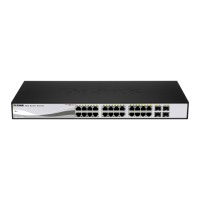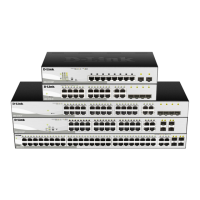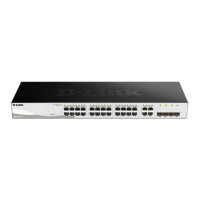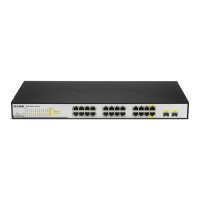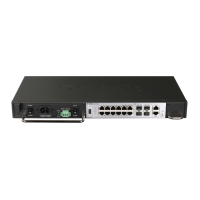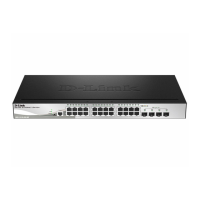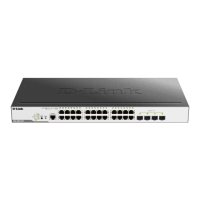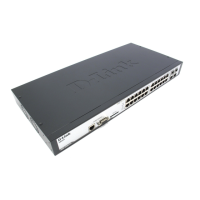
Do you have a question about the D-Link DGS-1210-52/ME and is the answer not in the manual?
| Product Type | Managed Switch |
|---|---|
| Number of Ports | 52 |
| Switching Capacity | 104 Gbps |
| Forwarding Capacity | 77.4 Mpps |
| Forwarding Rate | 77.4 Mpps |
| MAC Address Table Size | 16K |
| Jumbo Frame | 9KB |
| Ports | 48 x 10/100/1000BASE-T, 4 x SFP |
| Layer | Layer 2+ |
Instructions for unpacking the switch and verifying contents.
Guides the user through installing the switch physically.
Guide for placing the switch on a desk or shelf, including rubber pad attachment.
Instructions for mounting the switch in a standard 19-inch rack using brackets.
Procedure for connecting the AC power cord to the switch and an outlet.
Guides the user on how to access and use the switch's web interface.
Detailed steps on how to access the switch's web interface via its IP address.
Overview of the switch's web-based management interface layout.
Accesses functions for saving switch configuration and logs.
Provides access to system tools like reset, reboot, backup, and firmware management.
Describes how to safely reboot the switch through the interface.
Details methods for backing up and restoring switch configuration.
Explains how to save and update the switch's firmware.
Configures basic system information, including IP address and system name.
Allows configuration of IPv6 system settings and interfaces.
Manages static ARP entries for IP to MAC address resolution.
Configures IPv6 system information and settings.
Configures port speed, duplex, and MDI/MDIX settings.
Enables or disables the global SNMP function on the switch.
Manages SNMPv3 user accounts and their authentication settings.
Associates SNMP users with groups, defining access policies.
Defines MIB objects accessible by community strings.
Manages user accounts, privileges, and passwords.
Configures how system logs are generated and managed.
Manages VLAN configurations and settings.
Adds new VLAN groups by assigning ports and defining VLAN attributes.
Configures private VLAN settings, including primary and secondary VLANs.
Creates MAC-based VLAN entries to map MAC addresses to VLANs.
Enables or disables Q-in-Q functionality for service provider networks.
Configures VLAN trunk settings to combine multiple VLAN ports.
Configures link aggregation to combine multiple ports for increased bandwidth.
Configures LACP port settings for link aggregation.
Configures BPDU protection to prevent STP loops.
Enables and configures IGMP snooping for intelligent multicast forwarding.
Configures IGMP snooping global and per-VLAN parameters.
Configures global settings for DHCP/BOOTP relay services.
Configures global Spanning Tree Protocol (STP) settings.
Configures STP settings on a per-port basis.
Identifies Multiple Spanning Tree instances (MSTIs).
Configures STP instance settings and priorities.
Configures ERPS (Ethernet Ring Protection Switching) settings.
Controls traffic rates for broadcast, multicast, and unicast packets.
Defines bandwidth settings for port transmitting and receiving rates.
Selects CoS scheduling mechanisms (WRR or Strict Priority).
Sets default 802.1p priority for ports, managing bandwidth for important functions.
Classifies packets based on DSCP field for priority queuing.
Configures CoS priority settings on a per-port basis.
Manages trusted management stations allowed access to the switch.
Protects the switch CPU from malicious attacks by throttling packet flooding.
Configures CPU protection types and rate limits.
Prevents unauthorized devices by controlling MAC address learning on ports.
Configures SSL for secure web management and allows certificate download.
Configures IP-MAC-port binding rules for restricting client access.
Creates static IP-MAC-port binding entries.
Configures 802.1X authentication modes and protocols.
Configures RADIUS server settings for centralized 802.1X authentication.
Manages static MAC addresses, disabling auto-learning on ports.
Defines administrator-based authentication policies for user access.
Groups TACACS+/RADIUS servers for authentication using method lists.
Configures TACACS+ and RADIUS server hosts for authentication.
Configures settings to prevent Denial of Service (DoS) attacks.
Restricts illegal DHCP servers by discarding service from distrusted ports.
Designs trusted DHCP server IP addresses and client MAC addresses.
Configures SSH server state, session limits, and timeouts.
Configures MAC-based Access Control global settings and authentication methods.
Creates a list of MAC addresses for local authentication.
Guides users through creating access profiles and ACL rules.
Configures Power over Ethernet (PoE) settings for individual ports.
Displays PoE status and manages system-wide power budget.
Creates and configures static IPv4 routing entries.
Creates and configures static IPv6 routing entries.
